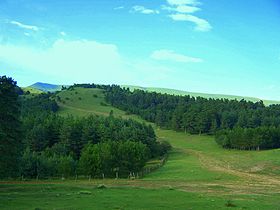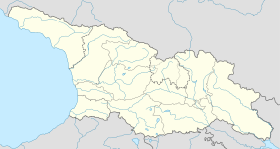
Summary
Manglisi (Georgian: მანგლისი, pronounced [manɡlisi]) is a daba (townlet) in the Tetritsqaro Municipality, Kvemo Kartli region of Georgia. As of the 2014 census, it had the population of 1,441.[1] With a recorded history going back to the 4th century, Manglisi was one of the earliest centers of Christianity in Georgia and is a home to the medieval cathedral of the Mother of God. It also functions as a mountain spa and health resort.
Manglisi
მანგლისი | |
|---|---|
Borough | |
 Environs of Manglisi | |
 Manglisi Location in Georgia  Manglisi Manglisi (Kvemo Kartli) | |
| Coordinates: 41°41′49″N 44°23′04″E / 41.69694°N 44.38444°E | |
| Country | |
| Region | Kvemo Kartli |
| Municipality | Tetritsqaro |
| Daba | 1926 |
| Elevation | 1,200 m (3,900 ft) |
| Population (2014)[1] | |
| • Total | 1,441 |
| Climate | Dfb |
Geography and climate edit
Manglisi is located on the southern slopes of the Trialeti Range, on the Tbilisi-Tsalka highway, 56 kilometres (35 mi) west of Tbilisi, the capital of Georgia, in the Algeti river valley. It is located at about 1,200 metres (3,900 ft) above sea level and enjoys a subtropical climate, with warm summers (average temperature in July, 19 °C) and mild winters (average temperature in January, −2 °C). Annual precipitation is 700 mm. Manglisi also functions as a mountain resort.[2]
Etymology edit
The etymology of "Manglisi" may be related to the Old Georgian mangali, "sickle",[3] ultimately derived from the Syrian maggəlā.[4] The modern Georgian scholar Ketevan Kutateladze has conjectured that, the name of the locality, in the sense of "a crescent", may be a reflection of the Moon cult,[5] an effect of which persisted in the system of religious beliefs of Georgians into the era of Christianity.[6]
History edit
Antiquity and Middle Ages edit
In the early Bronze Age, the territory of Manglisi was part of the wider region, home to a kurgan culture.[7] By the early Middle Ages, Manglisi and its environs strategically located on the course of the Algeti river formed a territorial unit known as Manglis-khevi, "the valley of Manglisi".[5]
The Georgian historical tradition makes Manglisi, along with Mtskheta and Erusheti, one of the earliest church establishments in Kartli (Iberia) following King Mirian's conversion to Christianity in the 330s. According to the 11th-century historian Leonti Mroveli, Manglisi was the first place which the bishop John of Kartli, returning from his mission to Constantinople with a group of Byzantine priests and masons, chose to build a Christian church. There, the chronicle continues, he left the relics brought from Constantinople as presents of the emperor Constantine the Great, to the disappointment of King Mirian who wanted to have the relics at his capital, Mtskheta.[8]
Manglisi became a seat of the homonymous bishopric under Vakhtang I in the 5th century.[9] The diocesan territory of Manglisi covered much of the Algeti valley and at times expanded beyond it.[5] The church of Manglisi was also a site of pilgrimage for the neighboring Armenians until the catholicos Abraham of Armenia excommunicated the Georgians following an ecclesiastic schism between the two peoples in 607 and instructed his compatriots not to go on pilgrimage to Mtskheta and Manglisi.[10] Manglisi was dispossessed of its relic, the foot-rest (suppedaneum) of the Lord, by the Byzantine emperor Heraclius who passed through Kartli during his war with Iran in the 620s.[11][12]
The valley of Manglisi appears in possession of the Juansheriani family,[13] a branch of the former royal dynasty of Chosroids of Iberia, in the middle of the 8th century,[14] and then of the Liparitids, whose one member Rati, a contemporary of Bagrat III (r. 978/1008–1014), is described by the Georgian chronicler to have held "the fortress of Ateni and all Kartli south of the Mtkuari, Trialeti, Manglis-khevi, and Skvireti."[15] At the beginning of the 11th century, the cathedral of Manglisi, originally a tetraconch, was substantially reconstructed and refurbished.[16] In 1121, the field of Didgori, not far from Manglisi, was a scene of the climactic victory of the Georgian king David IV over the Seljuq Turks.[17] After a series of foreign invasions, more so following Timur's campaigns, the valley of Manglisi went into gradual decline. By the 1770s, it had been listed among the emptied eparchies of the Georgian church.[18] The abandoned cathedral still stood there, undisturbed by Georgia's Muslim intruders because, as the 18th-century historian Prince Vakhushti claims, they thought one of the frescoes in the church depicted Muhammad seated upon a lion.[19] The fresco is, in fact, an image of St. Mammes of Caesarea.[20]
Russian rule edit
After the arrival of the Russian rule in Georgia, the depopulated village of Manglisi (Russian: Манглис, Manglis) was chosen, in 1823, by General Aleksey Yermolov as the headquarters of one of the regiments under his command, to be called, after 1827, the 13th Erivansky Grenadier Regiment for its role in the victory at Erivan in the war with Persia.[21] On this occasion, the Russian authorities had also transplanted some civilian families from the neighboring districts. By the early 1850s, Manglis had been a relatively well-organized Russian colony.[22] The old cathedral was also restored from 1851 to 1857.[23] The population, with an overwhelming Slavic majority, was up to 3,000 in 1892.[24] By the early 1890s, Manglis had also acquired a spa town status, where the people of Tiflis (Tbilisi) could escape the city's summer heat.[25]
Modern Manglisi edit
During the Soviet period, Manglisi continued to function as a spa and its sanatoriums provided services for people with respiratory diseases.[2] In 1924, the state-run airline Zakavia organized a short-lived line Tiflis—Manglis to serve local tourist interests.[26] On August 29, 1924, the Red Army barracks in Manglisi were raided, ultimately unsuccessfully, by anti-Soviet insurgents led by Kakutsa Cholokashvili.[27]
In 1926, the settlement was granted the status of daba (urban-type settlement). According to the nationwide Georgian census of 2002, Manglisi had the population of 2,752, a 30.1% drop from 3,939 in the last Soviet census of 1989.[28]
Notes edit
- ^ a b "Population Census 2014". www.geostat.ge. National Statistics Office of Georgia. November 2014. Retrieved 28 June 2021.
- ^ a b Great Soviet Encyclopedia 1982, p. 419.
- ^ Brosset 1831, p. 151.
- ^ Greppin 1997, p. 250.
- ^ a b c Kutateladze 2009, p. 134.
- ^ Allen 1932, pp. 37–38.
- ^ Sagona 1984, p. 208.
- ^ Thomson 1996, p. 131.
- ^ Thomson 1996, p. 217.
- ^ Rapp 2003, p. 169.
- ^ Thomson 1996, p. 236.
- ^ Toumanoff 1963, p. 392.
- ^ Thomson 1996, p. 247.
- ^ Toumanoff 1963, p. 402, 407 n. 2.
- ^ Thomson 1996, p. 276.
- ^ Dzhanberidze 1965, pp. 48, 51.
- ^ Thomson 1996, p. 332.
- ^ Kutateladze 2009, pp. 134–135.
- ^ Wakhoucht 1842, p. 171.
- ^ Constantinides 2007, p. 214.
- ^ Bobrovsky 1895, pp. 40–43.
- ^ Bobrovsky 1895, p. 281.
- ^ Bobrovsky 1898, p. 414.
- ^ Bobrovsky 1898, p. 406.
- ^ Brockhaus and Efron 1896, p. 527.
- ^ Andersson 1994, p. 58.
- ^ Javakhishvili 2005, p. 68.
- ^ National Statistics Office of Georgia 2003, p. 94.
References edit
- Allen, William Edward David (1932). A History of the Georgian People: From the Beginning Down to the Russian Conquest in the Nineteenth Century. London: Kegan Paul (repr. Barnes & Noble, 1971). ISBN 0-7100-6959-6.
- Andersson, Lennart (1994). Soviet aircraft and aviation, 1917-1941. Annapolis, Maryland: Naval Institute Press. ISBN 1557507708.
- Bobrovsky, Pavel (1895). История 13-го Лейб-Гренадерского Эриванского Его Величества полка за 250 лет. Часть четвертая [History of His Majesty's 13th Erivansky Leib Grenadier Regiment for 250 years. Part IV] (in Russian). St.-Setersburg: V. S. Balashev Typography.
- Bobrovsky, Pavel (1898). История 13-го Лейб-Гренадерского Эриванского Его Величества полка за 250 лет. Часть четвертая [History of His Majesty's 13th Erivansky Leib Grenadier Regiment for 250 years. Part V] (in Russian). St.-Setersburg: V. S. Balashev Typography.
- "Манглисъ" [Manglis']. Brockhaus and Efron Encyclopedic Dictionary (in Russian). Vol. XVIIIА (36). St.-Petersburg: Semionov Typography. 1896.
- Brosset, Marie-Félicité (1831). Chronique géorgienne, traduite par m. Brosset jeune membre de la Société asiatique de France [Georgian Chronicle, translated by Mr. Brosset, junior member of the Asiatic Society of France] (in French). Paris: De l'Imprimerie royale.
- Constantinides, Efthalia C. (2007). Images from the Byzantine periphery: studies in iconography and style. Leiden: Alexandros Press. ISBN 978-90-806476-7-1.
- Dzhanberidze, Nodar (1965). Architectural monuments in Georgia. Tbilisi: Literatura da Khelovneba.
- Greppin, John A. C. (1997). "Syrian Loanwords in Classical Armenian". In Zahniser, A. H. Mathias (ed.). Humanism, Culture, and Language in the Near East: Studies in Honor of Georg Krotkoff. Eisenbrauns. pp. 247–253. ISBN 1575060205.
- Javakhishvili, Niko (2005). Борьба за свободу Кавказа: Из истории военно-политического сотрудничества грузин и северокавказцев в первой половине XX века [Fight for liberty of the Caucasus: from the history of military-political cooperation between Georgians and North Caucasian in the first half of the 20th century] (in Russian). Tbilisi: Tbilisi State University Press. ISBN 99940853-4-4.
- Kutateladze, Ketevan (2009). Ioseliani, Khatuna (ed.). "The Border of Manglisi Eparchy" (PDF). Studies in History and Ethnology. XII. Tbilisi: Ivane Javakhishvili Institute of History and Ethnology: 116–135. ISSN 1512-2727. Retrieved 28 August 2012.
- Prokhorov, Alexander, ed. (1982). "Manglisi". Great Soviet Encyclopedia. Vol. 15. New York: Macmillan Publishers.
- Beridze, Teimuraz, ed. (2003). საქართველოს მოსახლეობის 2002 წლის პირველი ეროვნული საყოველთაო აღწერის შედეგები, ტომი I [Results of the first national census of the population of Georgia in 2002, volume I] (PDF) (in Georgian). Tbilisi: National Statistics Office of Georgia. ISBN 99928-0-768-7. Retrieved 28 August 2012.
- Rapp, Stephen H. (2003). Studies in Medieval Georgian Historiography: Early Texts And Eurasian Contexts. Leuven: Peeters Publishers. ISBN 90-429-1318-5.
- Sagona, Antonio (1984). The Caucasian region in the early Bronze Age, Volume 1. Oxford: B.A.R. ISBN 0860542777.
- Thomson, Robert W. (1996). Rewriting Caucasian history: the medieval Armenian adaptation of the Georgian chronicles; the original Georgian texts and the Armenian adaptation. Oxford: Clarendon Press. ISBN 0198263732.
- Toumanoff, Cyril (1963). Studies in Christian Caucasian history. Washington, DC: Georgetown University Press.
- Wakhoucht, Tsarévitch (1842). Brosset, Marie-Félicité (ed.). ღეოღრაჶიული აღწერა საქართველოჲსა. Description géographique de la Géorgie [Geographic description of Georgia] (in Georgian and French). S.-Pétersbourg: A la typographie de l'Academie Impériale des Sciences. Retrieved 28 August 2012.


